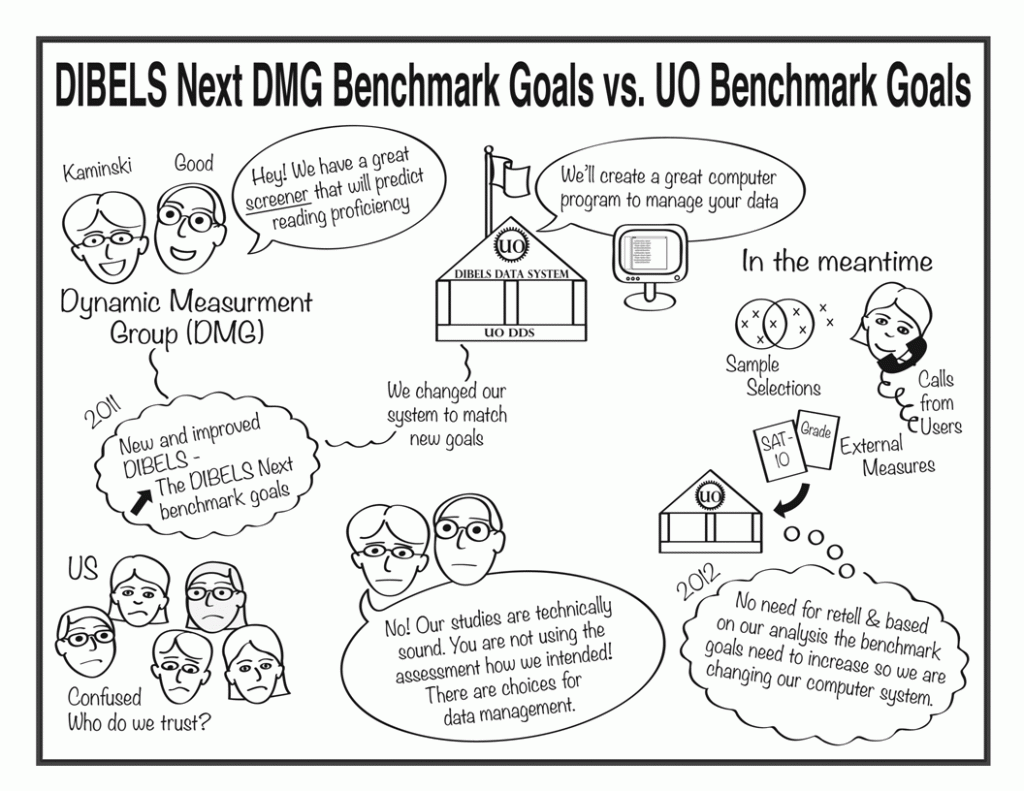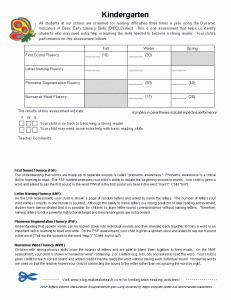I have to say this fall started in an absolute chaos. All of our elementary buildings use the DIBELS Next universal screener to identify students who may be at-risk for reading difficulties. Shortly after our first few days of school we received Part II: DIBELS Next Benchmark Goals from the University of Oregon Center on Teaching and Learning (CTL) in which the benchmark goals for each assessment dramatically increased. Let me give you an example. In the fall of first grade, using last year’s benchmark goals, we would expect a child to achieve 27 correct letter sounds (cls) and 1 whole word read (wwr) on the Nonsense Word Fluency assessment. Using the new “recommended goals” proposed by the CTL, we now would expect 42 cls and 7 wwr. Oh my gosh! That’s a dramatic increase in expectations. This increase in goals held true for all grade levels and for every subtest. After our schools received and read the document, panic set in and the phone calls started flying!
Through all the ensuing chaos over the next few days, there was one thing that became evident early on. The CTL and the authors of the DIBELS Next are not one and the same. I’m not sure why we thought they were, but shortly after reading Part II, we stumbled upon a document from the authors (aka Dynamic Measurement Group) in which they adamantly disagreed with the CTL recommended goals. Since that time they’ve made a DIBELS Next Benchmark Goals video explaining their position. Okay, I’m one of those visual people who survived graduate school by drawing everything out. I was feeling that this issue, for sure, needed a cartoon so that I could wrap my head around what I thought was going on.
Click the following link if you’d like a copy of the cartoon DIBELS Next Benchmark Goals Explained
After taking a few collective deep breaths, we decided to hold an “Emergency DIBELS Next Meeting”. Present at this meeting were Reading Specialists from our local districts, Teacher Consultants, Psychologists, and an administrator. The room was filled. Each of us read the CTL Part I and Part II documents as well as the DMG document. Papers were highlighted and notes scribbled along the sidebars. We were not going to leave the room until we came to consensus as to which goals to use for this school year. A Pros/Cons list was developed for moving to the CTL recommended goals. In a nutshell, we decided to continue to use the DMG goals for this school year for the following reasons:
Following our meeting, we came across a document that was developed by Michigan’s Integrated Behavior and Learning Support Initiative (MiBLSi). Although they did not make a formal recommendation as to which goals to use, they developed a pretty nice chart to guide schools in their decisions. Sorry I couldn’t give you a direct link to the document. If you click on the above link and type in “DIBELS Decision-Making Considerations” into their search box, the document will come right up.
So, for this school year, we are using the DMG goals and will use the UO computer system to manage the data. That meant that I needed to change the DIBELS Next parent handouts. If this is what you will be doing this year, feel free to download these handouts.
Click the following link to download the handouts DIBELS Next Parent Handouts K-6 DMG goals for the CTL computer system
If you are not using the CTL computer system to manage your data—maybe you are scoring by hand or using one of three other data management systems, the original DIBELS Next Parent Handouts, which can be downloaded for free, are still available on my Teachers Pay Teachers store.
As a group we may decide to continue with the DMG benchmark goals for the years to come or we may transition to the CTL. We need to do our own careful analysis. I have to say that I am so lucky to be working with such a large committee of intelligent, hard-working and skilled professionals that understand the value of collaboration. With any challenge that presents itself, we’ll figure this out together!




Hi Julie,
My name is Erin Chaparro. I’m a faculty member at the Center on Teaching and Learning at the UO. I just came across your blog and I just wanted to reach out to you. Do you have any questions? Or would you like to talk on the phone sometime? I’d be interested in hearing how your school’s experience has been with DIBELS in general and the DIBELS Data System. Here’s my phone number 541-346-1103. Feel free to give me a call or send me an email if you want to talk. I’d love to hear more from you. Thanks! Erin
P.S. Love the cartoon! You really do a great job of summarizing the confusion out there.
Thanks, Erin, for leaving a comment. For sure I’ll give you a call. Julie